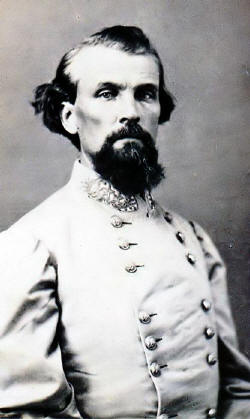General Nathan Bedford Forrest CSA
|
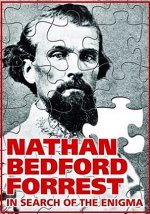 Nathan Bedford Forrest In Search of the Enigma The lost story of Nathan Bedford Forrest. Forrest was a pivotal character in the war, yet so much of his story has been swept aside in light of General Lee and other figures who were more recognized or perhaps more publicized. This is a must read 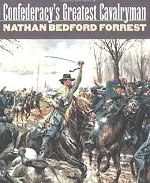 The Confederacy's Greatest Cavalryman: Nathan Bedford Forrest A renowned cavalryman, He perfected a ruthless hit-and-run guerrilla warfare that terrified Union soldiers and garnered the respect of warriors like Sherman, who described his adversary as "that Devil, Forrest. the most remarkable man our Civil War produced on either side." | ||||||||||||||||||||||||||||||||||||||||||||||||||||||||||||||||||||||||||||||||||||||||||||||||||||||||||||||||||||||||||||||||||||||||||||||||||||||||||||||||||||||||||||||||||||||||||||||||||||||||||||||||||||||||||||||||||||||||||||||||||||||||||||||||||||||||||||||||||||||||||||||||||||||||||||||||||||||||||||||||||||||||||||||||||||||||||||||||||||||||||||||||||||||||||||||||||||||||||||||||||||||||||||||||||||||||||||||||||||||||||||||||||||||||||||||||||||||||||||||||||||||||||||||||||||||||||||||||||||||||||||||||||||||||||||||||||||||||||||||||||||||||||||||||||||||||||||||||||||||||||||||||||||||||||||||||||||||||||||||||||||||||||||||||||||||||||||||||||||||||||||||||||||||||||||||||||||||||||||||||||||||||||||||||||||||||||||||||||||||||||||||||||||||||||||||||||||||||||||||||||||||||||||||||||||||||||||||||||||||||||||||||||||||||||||||||||||||||||||||||||||||||||||||||||||||||||||||||||||||||||||||||||||||||||||||||||||||||||||||||||||||||||||||||||||||||||||||||||||||
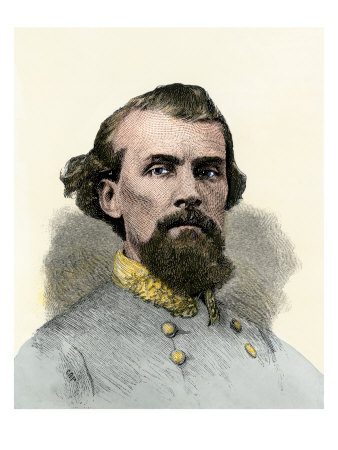
Confederate General Nathan Bedford Forrest 18 in. x 24 in. Buy at AllPosters.com Framed Mounted |
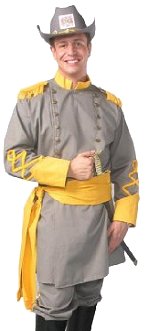 Adult Confederate Officer Uniform |
|
Forrest and his 10 siblings grew up well beyond the edge of the civilized world, in a two-room cabin in the middle of Tennessee. His father was a blacksmith and subsistence farmer, his mother a virtual giantess at six feet. Forrest survived the typhoid that killed half his siblings, including his twin, and at 21 left home to become a planter and slave trader in Memphis. He soon became one of the wealthiest men in the South. In 1861, when he was 40 years old, Tennessee seceded from the Union. The survival of the South, and of Forrest's livelihood, were suddenly thrown into doubt, and Forrest joined the Confederate Army. His violent temper was perfected in the theater of war: he immediately distinguished himself as a natural military genius. Sherman confessed to being perpetually flummoxed by Forrest's feral cunning and exhausted by his energy. In his first engagement, in Kentucky, Forrest defeated a Union force twice the size of his own. In subsequent battles, he took on and defeated, time and again, larger, better-equipped, and more thoroughly trained forces, often by dint of subterfuge and deceit — more than once he tricked Union commanders into surrendering to his smaller force — but just as often by ferocity and shrewdness. He fought alongside his troops, and by the end of the war had personally killed 30 enemy soldiers. His own horses fared only a little better. He had 29 shot from underneath him, sometimes one within minutes of its ill-fated successor. He was wounded four times, two bullets coming to rest near his spine. In the spring of 1864, low on provisions, Forrest attacked and captured Fort Pillow, a garrison north of Memphis. The incident became perhaps the most controversial military action in the Civil War, as Forrest had at his command more than twice as many soldiers as were occupying the fort, about half of whom were recently freed slaves. Surrounded and outnumbered, the Union forces declined to surrender, and, typically, Forrest was ruthless. His men overran Fort Pillow, taking few prisoners. The Union called the battle a massacre. Forrest would later appear before Congress to defend himself against charges of war crimes, and though he was found not guilty, he was known to many, for the rest of his life, as the Butcher of Fort Pillow. Post-War Years in Tennessee Meanwhile, in Pulaski, Tennessee, six Confederate veterans had formed, as a lark, a secret society that they whimsically dubbed the Ku Klux Klan (from the Greek word for circle, kuklos — they evidently liked the mystical ring of the alliterated k's.) At first, the six men and their recruits undertook non-violent, theatrical stunts to frighten back into line the freed slaves just beginning to assert their new rights. But soon enough, more men joined the KKK and, as Republican efforts to rehabilitate Southern society grew more concerted, the KKK became a violent, marauding organization whose individual "dens" answered to no centralized authority. Society was changing quickly, and the KKK was trying to slow the pace. Bodies of freedmen, their white supporters, and Republicans began to litter the roadside. It was at about this time that Forrest, learning of the KKK, expressed a desire to join. The eminent recruit was elected grand wizard, the Klan's highest official, and tried to bring the rapidly multiplying dens under a centralized authority — his own. Forrest probably did not object to the violence, per se, as a means of restoring the pre-war hierarchy, but as a military man, he deplored the lack of discipline and structure that defined the growing KKK. In its methods and aims, the KKK was merely the avenging ghost of the Confederate army. To Forrest's dismay, though, it was not an army that he could command. After only a year as Grand Wizard, in January 1869, faced with an ungovernable membership employing methods that seemed increasingly counterproductive, Forrest issued KKK General Order Number One: "It is therefore ordered and decreed, that the masks and costumes of this Order be entirely abolished and destroyed." By the end of his life, Forrest's racial attitudes would evolve — in 1875, he advocated for the admission of blacks into law school — and he lived to fully renounce his involvement with the all-but-vanished Klan. A new, different, and much worse Klan would emerge, 35 years after Forrest's death, in the wake of D.W. Griffith's revolutionary 1915 film, Birth of a Nation, a reactionary screed with a racialist brief that had been expanded to include Catholics and immigrants of all kinds. The second Klan was never restricted to the South; its goals had nothing to do with Forrest's vision of a restored Dixie. Nathan Bedford Forrest was a product of a divided society in which acts of racism were often considered good Christian behavior. He always suffered from a wild temper, bullied his subordinates and even his commanding officers, and was extremely violent. He grew up impoverished to a degree that few of us can imagine, and by ruthlessness and hard work rose to become one of the four or five most important actors in the American Civil War. Contemporary critics complained that he was ungallant, uncouth, and uneducated, not a grand Southern gentleman such as Robert E. Lee. Forrest himself would not have argued the point. But as a military mind and as a cultural artifact, Forrest is indispensable to a full understanding of the period. |
 Civil War Cannon Collectible Models and childrens playsets Miniature Collectible Civil War Cannon12 pound Civil War field cannon replica weapon collectible is a detailed 1/12th scale military caisson replica weapon collectible as used throughout the Civil War Childrens Cannon Set. Includes 6 gray cannon with black wheels that measure 4.5 inches long | 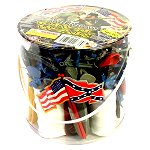 Civil War Soldier 102 Piece Playset
|
Kindle Available Nathan Bedford Forrest's Escort And Staff The CSA escort company and staff officers of Nathan Bedford Forrest were held in awe by men on both sides of the conflict during the war and long after, and they continue to be held in esteem as figures as legendary as Forrest himself. Not merely guards or couriers, these men were an elite force who rode harder and fought more fiercely than any others |
Kindle Available Nathan Bedford Forrest: A Biography Nathan Bedford Forrest was one of the most interesting figures from the mid-19th Century. He was also one of the most controversial -- given his role as Confederate cavalryman, Fort Pillow, and the rise of the first KKK |
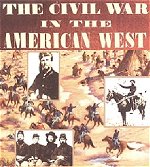 Civil War in the American West An accurate and detailed history of the Western Theater of the Civil War, which was largely forgotten by history. He was one of the first historians to fully understand the impact that California had on the war as he gives an accounting of the Federal raid on the Dan Showalter Ranch in San Bernadino on October 5, 1861. |
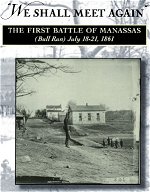 "We Shall Meet Again": The First Battle of Manassas (Bull Run), July 18-21, 1861 The First Battle of Manassas claimed the lives of approximately 878 soldiers and wounded another 2,489. With a battlefield stretching nearly five miles, 15,000 Union and 14,000 Confederate soldiers clashed for four fateful days, many of them young and terrified and receiving their first taste of a long and bitter war |
|||||||||||||||||||||||||||||||||||||||||||||||||||||||||||||||||||||||||||||||||||||||||||||||||||||||||||||||||||||||||||||||||||||||||||||||||||||||||||||||||||||||||||||||||||||||||||||||||||||||||||||||||||||||||||||||||||||||||||||||||||||||||||||||||||||||||||||||||||||||||||||||||||||||||||||||||||||||||||||||||||||||||||||||||||||||||||||||||||||||||||||||||||||||||||||||||||||||||||||||||||||||||||||||||||||||||||||||||||||||||||||||||||||||||||||||||||||||||||||||||||||||||||||||||||||||||||||||||||||||||||||||||||||||||||||||||||||||||||||||||||||||||||||||||||||||||||||||||||||||||||||||||||||||||||||||||||||||||||||||||||||||||||||||||||||||||||||||||||||||||||||||||||||||||||||||||||||||||||||||||||||||||||||||||||||||||||||||||||||||||||||||||||||||||||||||||||||||||||||||||||||||||||||||||||||||||||||||||||||||||||||||||||||||||||||||||||||||||||||||||||||||||||||||||||||||||||||||||||||||||||||||||||||||||||||||||||||||||||||||||||||||||||||||||||||||||||||||||||
Kindle Available Gettysburg--The First Day A detailed tactical description of the first day's fighting. The engagements in McPherson Woods, at the Railroad Cuts, on Oak Ridge, on Seminary Ridge, and at Blocher's Knoll, and the retreat of Union forces through Gettysburg |
Kindle Available Pickett's Charge--The Last Attack at Gettysburg Pickett's July 3, 1863 charge up Cemetery Ridge is the climactic event of the Battle of Gettysburg and the defining moment of the Civil War. |
Kindle Available On Gunnery: The Art and Science of Field Artillery from the American Civil War to the Dawn of the 21st Century The fascinating evolution of artillery from the battlefields of the American Civil War to the desert sands of the middle east at the dawn of the 21st Century. Chronicling the evolution of fire direction and control from the muzzle loaded cannons of the Union and Confederacy |
Kindle Available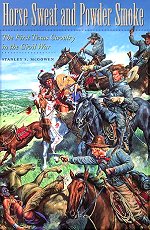 Horse Sweat and Powder Smoke The First Texas Cavalry in the Civil War Regimental history from the time the regiment was raised by Colonel McCulloch to defend against indian warriors tor the time the regiment was part of the Confederate Army under the Colonels Buchel and Yager until the end of the Civil War |
|||||||||||||||||||||||||||||||||||||||||||||||||||||||||||||||||||||||||||||||||||||||||||||||||||||||||||||||||||||||||||||||||||||||||||||||||||||||||||||||||||||||||||||||||||||||||||||||||||||||||||||||||||||||||||||||||||||||||||||||||||||||||||||||||||||||||||||||||||||||||||||||||||||||||||||||||||||||||||||||||||||||||||||||||||||||||||||||||||||||||||||||||||||||||||||||||||||||||||||||||||||||||||||||||||||||||||||||||||||||||||||||||||||||||||||||||||||||||||||||||||||||||||||||||||||||||||||||||||||||||||||||||||||||||||||||||||||||||||||||||||||||||||||||||||||||||||||||||||||||||||||||||||||||||||||||||||||||||||||||||||||||||||||||||||||||||||||||||||||||||||||||||||||||||||||||||||||||||||||||||||||||||||||||||||||||||||||||||||||||||||||||||||||||||||||||||||||||||||||||||||||||||||||||||||||||||||||||||||||||||||||||||||||||||||||||||||||||||||||||||||||||||||||||||||||||||||||||||||||||||||||||||||||||||||||||||||||||||||||||||||||||||||||||||||||||||||||||||||
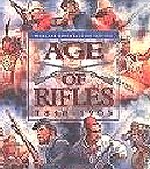 Wargame Construction Age of Rifles 1846 - 1905 Game lets you design and play turn-based strategic battles. You can create scenarios betwen years 1846 and 1905. You have complete control over all the units, and can customize their firepower, movement points, strength, aggressiveness, etc. Supports 1 or 2 players |
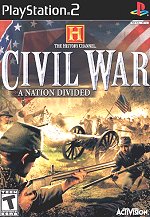 History Channel Civil War A Nation Divided Rally the troops and organize a counterattack -- Your strategic decision and talent as a commander will decide if the Union is preserved or if Dixie wins its independence |
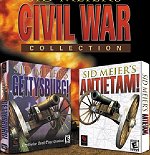 Sid Meier's Civil War Collection Take command of either Confederate or Union troops and command them to attack from the trees, rally around the general, or do any number of other realistic military actions. The AI reacts to your commands as if it was a real Civil War general, and offers infinite replayability. The random-scenario generator provides endless variations on the battles |
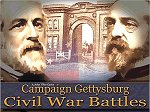 Campaign Gettysburg: Civil War Battles Campaign Gettysburg is simply the best of all the HPS Civil War games. While all of those are very good in their own right they simply do not compete with the level of detail presented here. Hundreds of scenarios and multiple OOBs are only the start, the best thing is the campaign game |
|||||||||||||||||||||||||||||||||||||||||||||||||||||||||||||||||||||||||||||||||||||||||||||||||||||||||||||||||||||||||||||||||||||||||||||||||||||||||||||||||||||||||||||||||||||||||||||||||||||||||||||||||||||||||||||||||||||||||||||||||||||||||||||||||||||||||||||||||||||||||||||||||||||||||||||||||||||||||||||||||||||||||||||||||||||||||||||||||||||||||||||||||||||||||||||||||||||||||||||||||||||||||||||||||||||||||||||||||||||||||||||||||||||||||||||||||||||||||||||||||||||||||||||||||||||||||||||||||||||||||||||||||||||||||||||||||||||||||||||||||||||||||||||||||||||||||||||||||||||||||||||||||||||||||||||||||||||||||||||||||||||||||||||||||||||||||||||||||||||||||||||||||||||||||||||||||||||||||||||||||||||||||||||||||||||||||||||||||||||||||||||||||||||||||||||||||||||||||||||||||||||||||||||||||||||||||||||||||||||||||||||||||||||||||||||||||||||||||||||||||||||||||||||||||||||||||||||||||||||||||||||||||||||||||||||||||||||||||||||||||||||||||||||||||||||||||||||||||||
 Civil War Nurse Barbie Part of the American Stories Collection. |
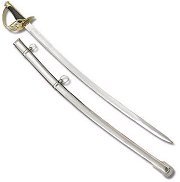 Cavalry Saber This fine replica is 39 inches overall and features a highly polished 33 inch carbon steel blade. Its leather wrapped handle fits the hand perfectly and sports decorative brass accents and a shiny brass pommel. |
 Civil War Model 1851 Naval Pistol Engraved Silver Tone / Gold Tone Finish and Wooden Grips - Replica of Revolver Used by Both USA / Union and CSA / Confederate Forces |
 1860 Enfield Civil War Musketoon This piece is a full-size non-firing reproduction of the rifle used in the Civil War. The body is made of European hardwood |
|||||||||||||||||||||||||||||||||||||||||||||||||||||||||||||||||||||||||||||||||||||||||||||||||||||||||||||||||||||||||||||||||||||||||||||||||||||||||||||||||||||||||||||||||||||||||||||||||||||||||||||||||||||||||||||||||||||||||||||||||||||||||||||||||||||||||||||||||||||||||||||||||||||||||||||||||||||||||||||||||||||||||||||||||||||||||||||||||||||||||||||||||||||||||||||||||||||||||||||||||||||||||||||||||||||||||||||||||||||||||||||||||||||||||||||||||||||||||||||||||||||||||||||||||||||||||||||||||||||||||||||||||||||||||||||||||||||||||||||||||||||||||||||||||||||||||||||||||||||||||||||||||||||||||||||||||||||||||||||||||||||||||||||||||||||||||||||||||||||||||||||||||||||||||||||||||||||||||||||||||||||||||||||||||||||||||||||||||||||||||||||||||||||||||||||||||||||||||||||||||||||||||||||||||||||||||||||||||||||||||||||||||||||||||||||||||||||||||||||||||||||||||||||||||||||||||||||||||||||||||||||||||||||||||||||||||||||||||||||||||||||||||||||||||||||||||||||||||||
Source:
U.S. Army Archives
PBS

